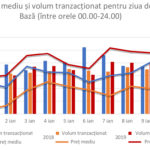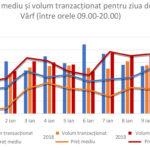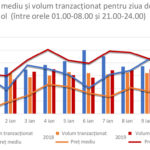Power prices on the OPCOM Day Ahead Market – DAM reached new record levels, at a medium level 411 lei/MWh for electricity with delivery on 10 January, according to market operator data. The average price for peak hours (09.00-20.00) exceeded 550 lei per MWh, with a maximum of 610 lei/MWh, for the time interval 16.00-18.00.
Over the past four days, the average base price on DAM was over 359 lei per MWh. The price for January 10, 2019 is more than double the monthly average in January 2018 (155.7 lei/MWh, a 163% increase) and January 2016 (184.38 lei/MWh, a 122% increase), but only 21% higher than the monthly average of January 2017 (337.74 lei/MWh).
- Sursa: date OPCOM, prelucrate de energynomics
- Sursa: date OPCOM, prelucrate de energynomics
- Sursa: date OPCOM, prelucrate de energynomics
Evolutions of prices on DAM come in the context of a demand not exceeding the 9,555 level, in 2019, with the maximum demand on January 8. However, at peak hours, the domestic production deficit had to be covered by imports.
During the first 10 days of the year, Romania imported electricity for around 55% of the time, according to Transelectrica data (at a resolution of 10 minutes, from 00.00, January 1, 2019, until 10 January, 09.30).
Wind installed capacities have made an important contribution, over 1,400 MW, in 39% of the time. In the nuclear sector, capacity of almost 1,400 MW has been constantly in operation, hydrocarbons have contributed over 1,400 MW for 85% of the time, and coal contributed with 1,400 MW or more for 72% of the time in the first ten days of the year. Under conditions of drought and reduced hydraulicity for more than four months, Hidroelectrica brought into the system 2,208 MW at maximum and only for 37% of the time contributed more than 1,400 MW.
The prices point to the essential information
High DAM prices indicate the lack of flexibility of the national electro-energetic system. This can be explained in part by commercial considerations: erroneous consumption forecasts, non-large enough contracts and/or commercial indiscipline. Probably the most important factors come from the technical area: the most important is there are insufficient installed capacities for covering peak demand, but insufficient regional interconnection also plays a role. An almost completely ignored area of action that could help in an efficient manner, both from technical and financial perspective, is bringing more flexibility to the consumers by aggregation, dispatching and demand side response.
In 2017, minister of Energy Toma Petcu pointed to the “abnormally high” market share that the DAM has in the total market transactions, as a justification-accusation for the upward trend in prices. We have presented at that time
5 facts suggesting that electricity prices rise for other reasons
and we anticipated that
The prices would increase for the years to come
“We must be realistic: with an energy system which is old, inflexible and isolated from other energy markets, the prices will be increasing in the years and decades to come, at least as long as technological promises such as storage and solutions for distributed generation will not become current realities.”
Less than two years later, the theories of conspiracies, populism with no technical support, and statist interventionism have reached new peaks today, just like prices in the Day Ahead Market. For sure, the provisions of GEO 114/2018 are not the answers we need to reverse these trends.



